What credit markets are telling us about Asia in 2009
Investor confidence seems slowly to be returning to Asian stock markets. Unfortunately, says Cris Sholto Heaton, that confidence is probably misplaced. Because, while equities may be starting to improve, the credit markets are pricing in considerable distress in the coming months.

table.ben-table table { border: 3px solid #2b1083;font: 0.928em/1.23em verdana, arial, sans-serif;}
th { background: #2b1083; padding: 10px 10px;color: white;font-weight: bold;text-align: center;border-left: 1px solid #a6a6c9;}th.first { border-left: 0; text-align: left;}
tr {background: #fff;}
MoneyWeek
Subscribe to MoneyWeek today and get your first six magazine issues absolutely FREE

Sign up to Money Morning
Don't miss the latest investment and personal finances news, market analysis, plus money-saving tips with our free twice-daily newsletter
Don't miss the latest investment and personal finances news, market analysis, plus money-saving tips with our free twice-daily newsletter
tr.alt {background: #f6f5f9; }
td { padding: 1px 2px;text-align: center;border-left: 1px solid #a6a6c9;color: #000;vertical-align: center;}td.alt { background-color: #f6f5f9; }
td.bold { font-weight: bold; }th.first, td.first { border-left: 0; text-align: left;}
Happy New Year. I'd like to be able to say that 2009 is shaping up to be considerably better than when I last wrote but unsurprisingly it's not. What little news there was during the last couple of weeks just confirmed that Asia's growth is still slowing sharply.
In China, for example, manufacturing activity fell for a fifth month, according to brokerage CLSA's monthly survey. Meanwhile, the central bank reported that non-cash payments fell during the third quarter of the year for the first time ever. Most of that was probably due to fewer transactions by small and medium-sized firms the type of businesses that are in the most trouble (along with real estate developers).
The story was similar across most of Asia. Japan's exports dropped by a record 26.7% year-on-year in November. India's exports plunged 9.9%, while industrial production unexpectedly fell for the first time in 15 years. Vietnam announced that GDP growth last year was the weakest this decade.
You might have expected this to hit stock markets badly. But in fact they were largely unworried. Investor confidence seems to be slowly returning the bad news is, it's probably over-confidence
As you can see in the chart below, the MSCI Asia ex-Japan index moved little over the last three weeks.
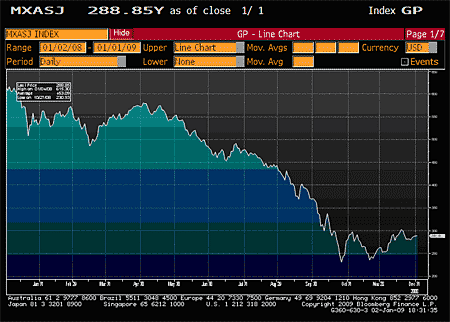
Investors are already expecting the first half of 2009 to be weak, and everything we see at the moment seems to confirm that. But the consensus is that conditions will be much better in the second half: most forecasters still expect the US economy to slowly pick up in the third quarter, taking the rest of the world with it.
Given the extent of the world's problems, that's very optimistic. But it will take a while before that's obvious. So I'm expecting the weak rally that we've already seen since October to pick up over the next few months, helped by the fact that this is usually the strongest part of the year. (Of course, in an efficient market, consistently weaker and stronger months shouldn't exist but history suggests they often have, so people trade on that basis, creating something of a self-fulfilling prophecy).
The debt markets are more worried
But that's unlikely to be the end of the bear market. While equities are starting to improve, credit markets are still pricing in considerable distress ahead.
Take a look at the index below, which measures the spread between a basket of Asian bonds and US government bonds (the risk-free' benchmark). As you can see, investors demand over ten percentage points more in yield to hold this basket of Asian bonds compared with treasuries, and that premium has barely fallen since the peak in November.
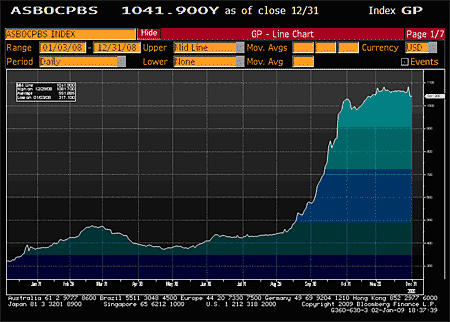
No markets have a great track record when it comes to forecasting the future. But bonds are generally better at picking up near-term trends than equities. And they clearly don't like what they're seeing. Even though some markets are starting to respond to the huge amount of money that central banks have pumped into the system, fear remains high.
The chart below shows the three-month Libor-OIS spread, which is the difference between the rate at which banks lend to each other for the next three months, and market expectations of US interest rates over the same period. As you can see in the lower panel of the chart, the spread has come down sharply from its peak, but it's still extremely high compared to normal.
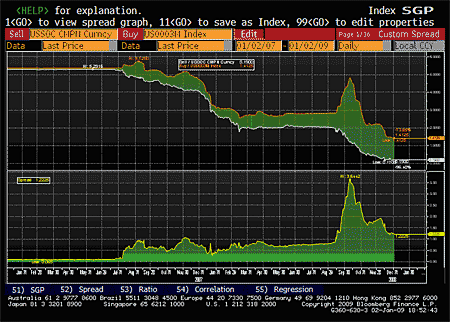
In short, we almost certainly have another sell-off coming when equity markets twig that things are even worse than they thought. Some time in the second quarter looks a likely candidate, since that should be the point when the promise of a second half recovery fades.
Good quality industrials look cheap
However, even although the bear market probably isn't over, the enormous sell-off we had last year means that there are a lot of attractive stocks out there for patient, long-term investors. Back in 2006 and 2007, valuations in every asset class were so excessive that there were few compelling investments. Today, the pendulum has swung to the opposite extreme: many stocks look extremely good value in any scenario short of a depression.
The outlook is still very murky. Diversification - including holding a large amount of cash - is the only prudent way to invest at the moment. Being 100% invested in Asian equities would be very unwise. But at these prices, picking up good quality industrial companies will probably look a very smart move in five years' time, even though their earnings are certain to be hit hard over the next year.
So part of my strategy in 2009 will be looking for stocks that I think are simply too cheap on a long-term view, regardless of how tough the short term will be. Clearly this carries risks: the major one is that if a company gets into trouble in these conditions, the credit crunch means that its chances of survival are much lower than normal. Each individual stock like this should only be held as a small part of a well-balanced portfolio. With that in mind, let's take a look at one company that I think fits the ticket.
A low-cost leader in electronics
Kingboard (HKG:0148) is a Chinese manufacturing group that produces the printed circuit boards (PCBs) used in computing and electronics applications. Beginning in 1988 as an intermediate producer of the laminates that make up the layers on a PCB, it now covers the supply chain from raw materials for the laminates to the finished boards.
The main firm is Hong Kong-listed Kingboard Chemical Holdings, which in turn controls three other listed companies: Hong Kong-listed Kingboard Laminates and Singapore-listed Kingboard Copper Foil and Elec & Eltek. The overall group is a leading low-cost manufacturer in its field: the global number one in laminates and top ten in PCBs.
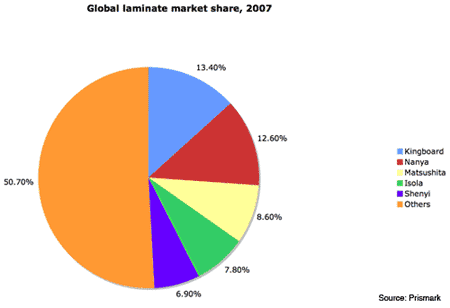
Kingboard's products are a very important part of the modern world and the firm's plants are based in the right place. China is steadily stealing market share in electronics manufacturing from its Asian neighbours, as it shifts from making toys to tech.
Laminates and PCBs are a relatively slow-growing mature industry, albeit one with fairly high barriers to entry because of the capital expenditure needed to get started. This means that Kingboard has a strong position in its core business.
For future growth, Kingboard is building up its chemicals unit, using the cashflow from the laminates and PCB divisions to fund new production plants for industrial chemicals such as methanol. Chemicals accounted for around 30% of sales and 41% of profit in the first half of 2008, although this was exceptionally high, boosted by higher chemical prices (see the charts below from Citigroup).
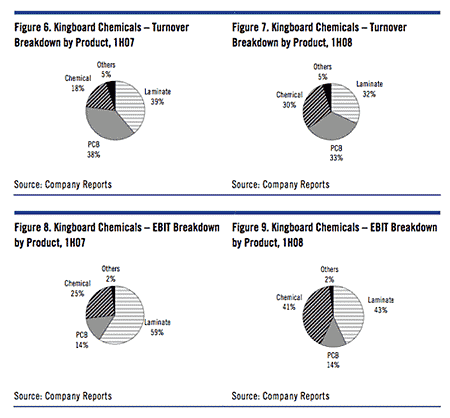
Management's projections at the start of 2008 were for a 15-20% per year overall growth rate over the next five years. However, given how cyclical its industries are, I strongly doubt that it will achieve anything like its recent performance in the near future. Analysts' forecasts for 2009 net income of HK$2.6bn and earnings per share of 3.29HK - look too high.
| 4.4 | 7.1 | 13.1 | 16.8 | 20.0 | 23.7 |
| Row 1 - Cell 0 | 60% | 85% | 28% | 19% | 18% |
| 0.5 | 1.1 | 1.4 | 7.1 (2.2*) | 2.8 | 3.1 |
| Row 3 - Cell 0 | 134% | 30% | 393% (50%*) | -61% (29%*) | 11% |
| 0.77 | 1.59 (2.59*) | 1.83 | 8.53 (2.59*) | 3.23 | 3.57 |
| Row 5 - Cell 0 | 107% | 15% | 366% (42%*) | -62% (25%*) | 10% |
| *Excluding 2006 gains from IPO of Kingboard Laminates |
Times are tough but the stock looks good value
But Kingboard is a leader in its industry and a 20-year trading history means that it has experience in riding out downturns. The forecast price/earnings ratio of 4.3 times isn't very meaningful here; it's a cyclical firm heading into a downturn and we must expect earnings to drop sharply. Price/book and dividend yield are more useful in this situation - and at 0.64 times and 7.9%, Kingboard looks cheap on these measures.
Financial strength is also important and Kingboard looks fairly solid. The bank debt to equity ratio stood at 56% at the end of June, with interest covered eight times by earnings. Around HK$2.9bn (25% of total debt) is due within a year: the firm has HK$5.4bn in cash against that and refinancing shouldn't be an issue for a large, established firm like this even in a credit crunch. However, given the weaker outlook for 2009, the firm has prudently halved its capital expenditure plans to HK$1.5-2bn and will use the spare cash generated to pay down borrowings.
The shares have come off sharply in the past year, as you can see on the chart below. Industrial midcaps are out of favour in Hong Kong and the sell-off has been pretty indiscriminate.
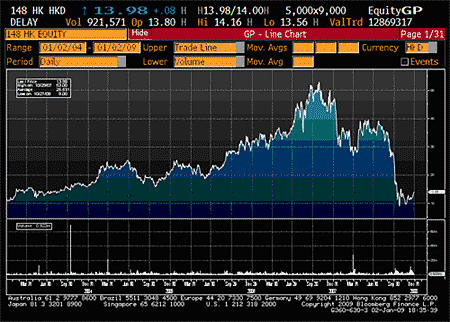
Kingboard undoubtedly has a tough year or two ahead of it, but the firm looks well-placed to survive and perhaps to take over weaker rivals. Sales should pick up strongly when the global economy starts to recover; in the meantime it should have the financial strength to survive and keep paying a solid dividend. There's certainly risk in buying now but for investors with an appetite for it, this stock looks like a good pick.
Kingboard Chemical Holdings
Exchange: Hong Kong
Ticker: 148
Price: HK$14
Market cap: HK$11.7bn
Turning to the markets
| China (CSI 300) | 1817 | -3.7% |
| Hong Kong (Hang Seng) | 15,043 | +5.8% |
| India (Sensex) | 9,958 | +6.7% |
| Indonesia (JCI) | 1,355 | +0.5% |
| Japan (Topix) | 859 | +1.2% |
| Malaysia (KLCI) | 894 | +2.7% |
| Philippines(PSEi) | 1,873 | -1.7% |
| Singapore (Straits Times) | 1,830 | +5.3% |
| South Korea (KOSPI) | 1,157 | +1.1% |
| Taiwan (Taiex) | 4,591 | +3.8% |
| Thailand (SET) | 450 | +2.5% |
| Vietnam (VN Index) | 313 | +3.7% |
| MSCI Asia | 82 | +3.4% |
| MSCI Asia ex-Japan | 289 | +2.7% |
Most Asia equity markets ticked up over Christmas, with the main exception being China. The CSI300 benchmark has slid around 10% over the last three weeks on extremely thin trading volume, as the morale boost from the government's flurry of announcements wears off.
Sentiment in the currency markets continued to improve, with all major Asian currencies up against the dollar over the last month. However, the Vietnamese dong fell to its lowest level since 1993, closing last week at 17,475, after the central bank devalued the currency in an effort to boost exports.
India announced several measures to lift the supply of credit and support the economy. The central bank cut interest rates for the fourth time since October, while the government increased the amount of bonds that foreign investors are allowed to hold and announced plans to inject capital into banks and finance firms.
In the commodity markets, crude palm oil rose back above MYR1800/tonne in Kuala Lumpur for the first time since October, helped by the rise in crude oil, which affects fuel demand for palm oil. Rubber has also been rising, with the benchmark SMR20 rubber contract now back to MYR4525/tonne, after Indonesia, Malaysia and Thailand announced plans to cut exports in a bid to buoy the market.
This article is from MoneyWeek Asia, a free weekly email of investment ideas and news every Monday from MoneyWeek magazine, covering the world's fastest-developing and most exciting region. Sign up to MoneyWeek Asia here.
Get the latest financial news, insights and expert analysis from our award-winning MoneyWeek team, to help you understand what really matters when it comes to your finances.
Cris Sholto Heaton is an investment analyst and writer who has been contributing to MoneyWeek since 2006 and was managing editor of the magazine between 2016 and 2018. He is especially interested in international investing, believing many investors still focus too much on their home markets and that it pays to take advantage of all the opportunities the world offers. He often writes about Asian equities, international income and global asset allocation.
Cris began his career in financial services consultancy at PwC and Lane Clark & Peacock, before an abrupt change of direction into oil, gas and energy at Petroleum Economist and Platts and subsequently into investment research and writing. In addition to his articles for MoneyWeek, he also works with a number of asset managers, consultancies and financial information providers.
He holds the Chartered Financial Analyst designation and the Investment Management Certificate, as well as degrees in finance and mathematics. He has also studied acting, film-making and photography, and strongly suspects that an awareness of what makes a compelling story is just as important for understanding markets as any amount of qualifications.
-
 Investors will reap long-term rewards from UK equities
Investors will reap long-term rewards from UK equitiesOpinion Nick Train, portfolio manager, Finsbury Growth & Income Trust, highlights three UK equities where he’d put his money
-
 The graphene revolution is progressing slowly but surely
The graphene revolution is progressing slowly but surelyEnthusiasts thought the discovery that graphene, a form of carbon, could be extracted from graphite would change the world. They might've been early, not wrong.
